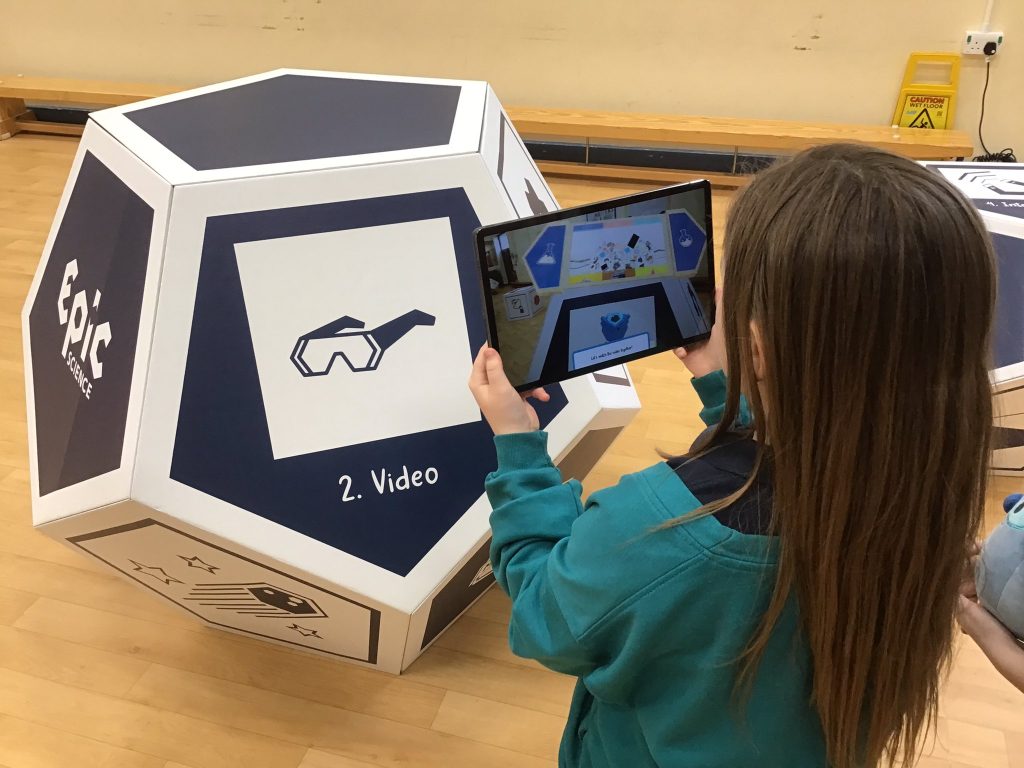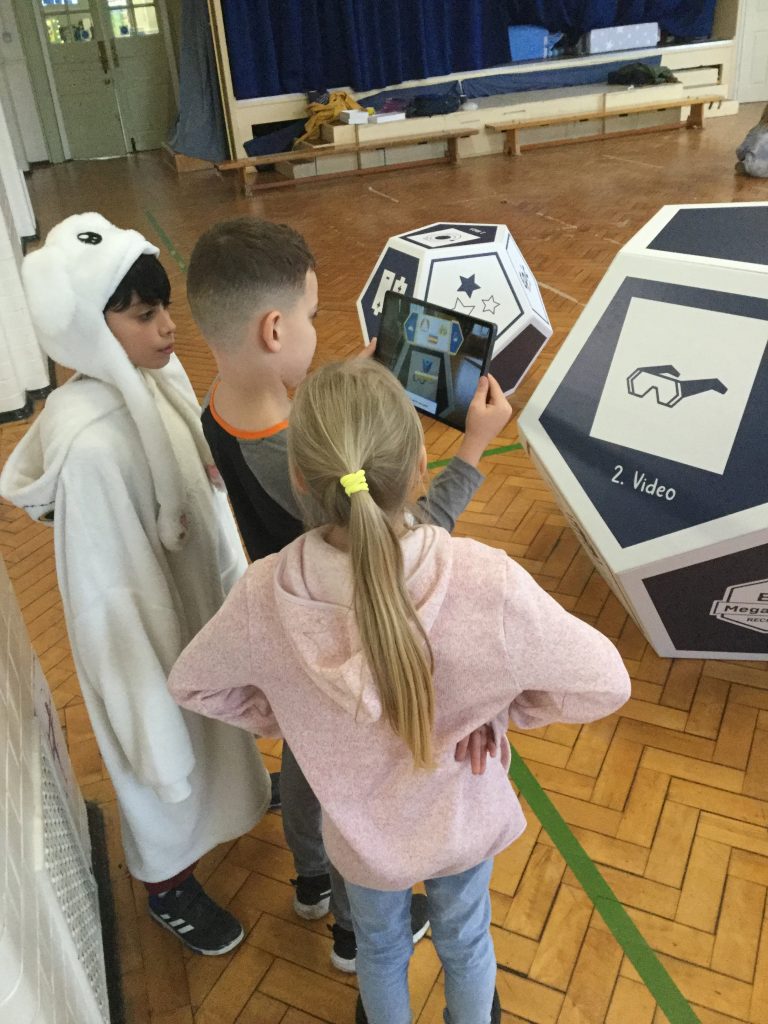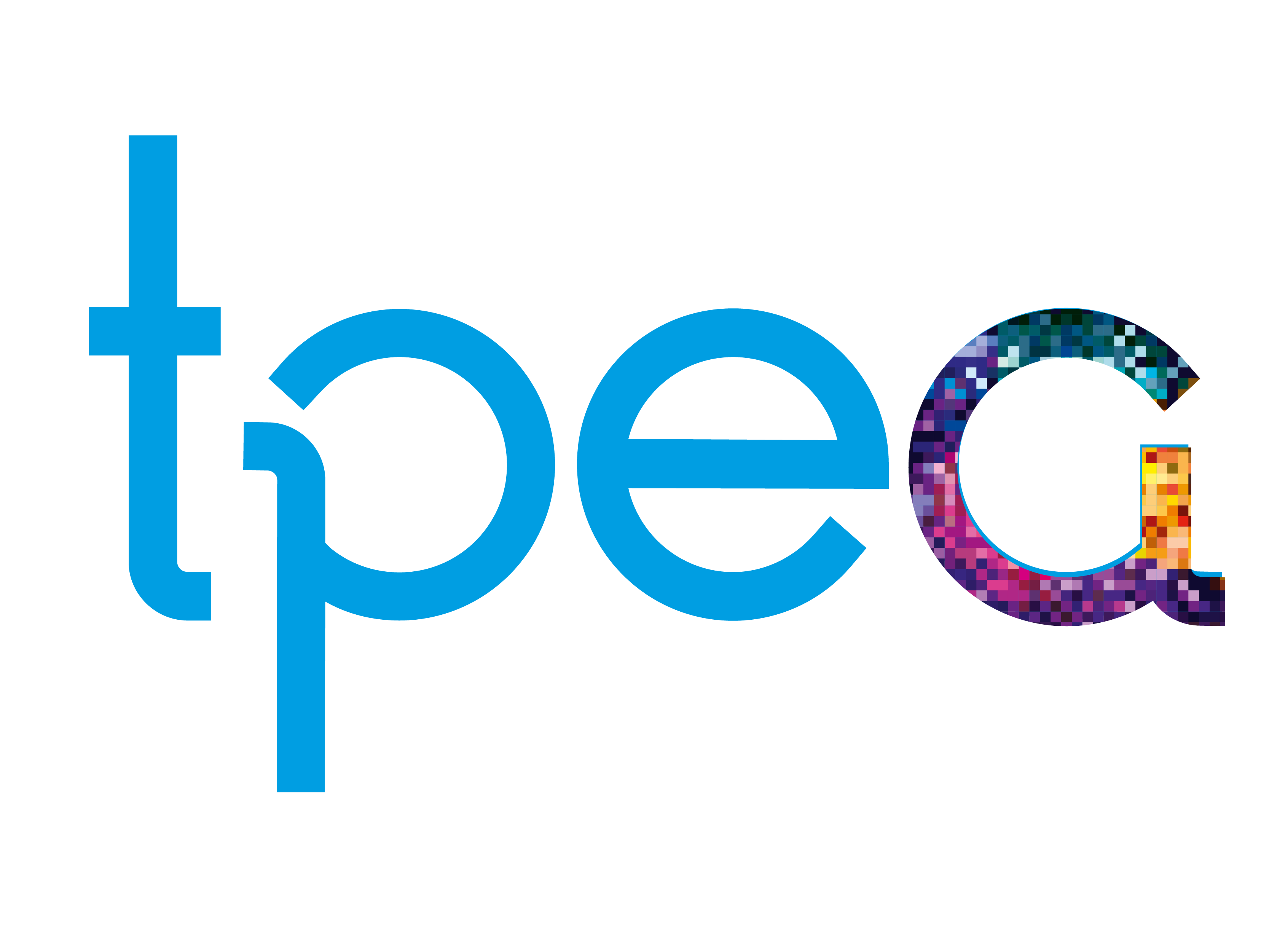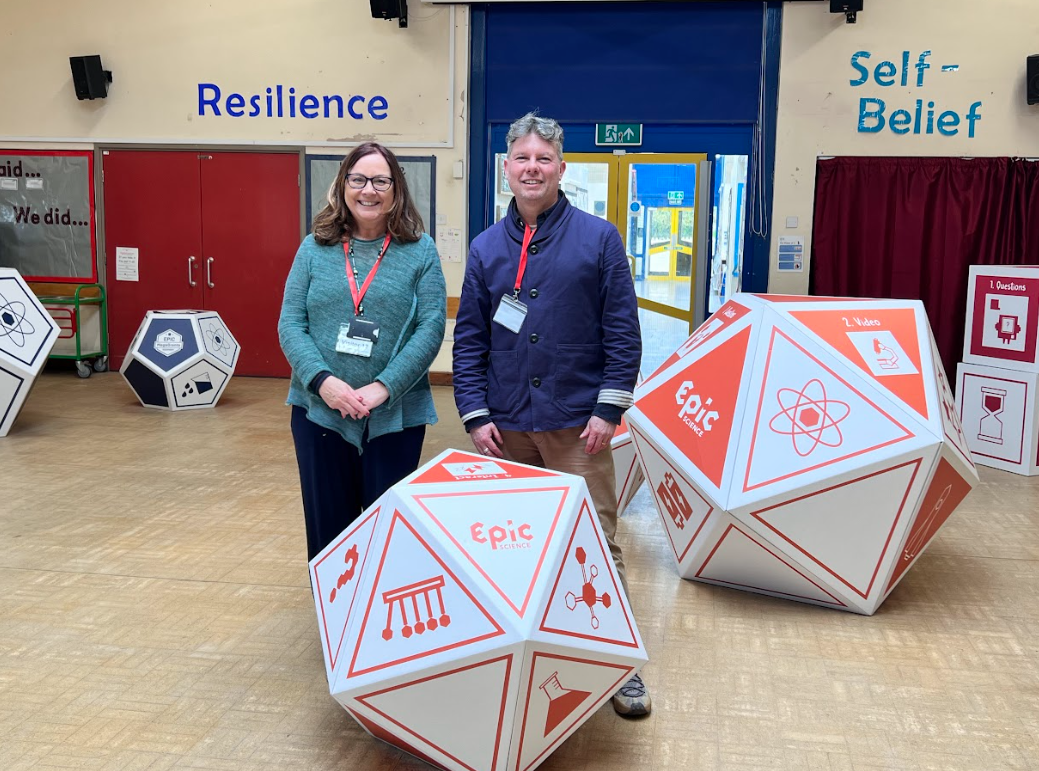
Warren Fearn, Associate Professor in Design at York St John University, Dr. Katy Bloom, Associate Professor in Education at York St John University, and Jake Reeves Kemp, IT leader at Ebor Academy Trust in York, convene to discuss their findings on the intervention of augmented reality (AR) in primary teaching.
The conversation delves into the challenges faced by primary science education since the 2009 disapplication of KS2 Science SATs, which has resulted in the teaching of science at primary level becoming more fragmented, despite it still being a core subject, This has coincided with a sea-change in children’s information consumption habits, who now have vast amounts of information at their fingertips through smartphones and platforms like TikTok and Instagram, which deliver content in short, digestible bursts. But how critical are they of the information they receive through these channels?
In response to these challenges, the EPIC AR PROJECT secured an Epic Mega Grant, sponsored by the creators of Fortnite, with the aim of fostering innovation among smaller teams, solo developers, and innovators. With this funding, the project aims to pioneer an immersive educational AR experience using the Unreal Games Engine. Through collaborative efforts, a pop-up AR exhibition focused on science relating to ‘climate change’ was designed to be implemented in schools across York and is currently being piloted in some York schools.
What is Augmented Reality?
Augmented Reality (AR) is a technology that overlays digital content onto the real world, enriching a user’s perception of their surroundings. Unlike Virtual Reality (VR), which immerses users in entirely virtual environments, AR seamlessly blends digital elements with the physical environment in real-time. Mixed Reality (MR) combines aspects of both AR and VR, allowing digital objects to interact with and respond to real-world elements. Extended Reality (XR) encompasses all immersive technologies, including AR, VR, and MR, along with other emerging digital experiences. While these terms share some similarities, they offer distinct experiences and applications.
AR’s ability to superimpose virtual objects onto physical environments facilitates visualisation of intangible concepts, aiding learners in understanding abstract ideas or unobservable phenomena (Wu et al., 2013). This immersive experience allows users to interact with digital content within their physical surroundings. Examples of AR applications include popular social media platforms such as Facebook, Instagram, and Snapchat, where brands leverage AR features to engage audiences through interactive and entertaining activities.
Service Design Approach
The Epic project adopts a service design approach, recognising that AR technology necessitates consideration of various factors beyond just screen interaction. Tim Brown of IDEO highlighted in 2009 that everyday devices, like mobile phones, are essentially services connecting users to communication networks. Therefore, to enhance services and overall customer experiences, service design employs a pragmatic process with four iterative steps: Exploration, Creation, Reflection, and Implementation.
The project commenced with an exploration stage (questionnaires, interviews, observations, and focus groups) with primary school teachers and key stage 2 pupils to gather user feedback. Subsequently, in the creation stage, a practical response in the form of a pop-up AR science exhibition, based on the insights obtained where science weeks provided an opportunity to deploy AR as an activity. Currently, in the implementation phase, the project is evaluating the impact of the AR exhibition on pupil engagement in schools across York, aiming to assess its effectiveness in enhancing primary science education. As the project progresses towards its conclusion, ongoing testing is being conducted to determine how augmented reality can effectively engage young people and teachers in this educational context, ensuring continuous refinement and reflection of the approach based on user feedback and outcomes.
Reflecting on prior research regarding augmented reality for primary schools (Fearn and Hook, 2023), there’s a need to explore why developers may overlook meaningful AR interventions in educational settings. There is common evidence from previous studies (Akcayir 2017; Wang 2017; Radu 2014 & Yuen 2011) that educators and learning designers need to collaborate in terms of creating sound pedagogy to develop AR applications that maximise on learning outcomes. Consequently, the EPIC project involves co-creation with key stakeholders. This collaboration extended to partnering with a blueprinting coder (GDXR Learn), utilising educational videos (ClickView), engaging a sound artist (Sonas Audio), and working with the Centre for Industry Education Collaboration to develop a functional AR prototype.
What did we initially learn around the barriers and opportunities for using AR in primary schools?
Primary schools face significant challenges related to budget constraints and disparities in resource allocation, with variations in device sharing among students posing a significant hurdle for adopting augmented reality (AR). Investment in portable devices is often determined by senior leadership teams, highlighting the need for strategic decision-making in resource allocation. Additionally, shifting teacher mindsets towards embracing new technologies like AR is essential, especially for educators who may feel apprehensive or lack digital literacy. Continuous professional development is crucial to support teachers in integrating AR into their teaching practices effectively, ensuring alignment with individual styles and needs. However, challenges such as limited access to devices, reliable Wi-Fi, time constraints, and IT restrictions further complicate the implementation of AR in primary classrooms. Despite these obstacles, teachers have explored the integration of AR and virtual reality (VR) experiences using applications like Google Expeditions, Aurasma, and Merge 3D. While AR is recognised as state-of-the-art technology, its use is often perceived as limited to ‘one-off’ engagements rather than a mainstream educational tool. To promote wider adoption, AR applications must align with the national curriculum framework in England, emphasizing clear pedagogical goals and assessment criteria. Teachers envision AR as a powerful medium to connect science concepts to students’ everyday lives, offering visualizations for abstract concepts and enhancing pupil engagement in STEM-related activities. Furthermore, AR presents opportunities to enrich science weeks and career fairs by creating interactive exhibitions that promote pupil engagement and contribute to the development of science capital among students.

Engaging and Learning through AR
There are undoubtedly concerns around ethical implications of using augmented reality. (Southgate et al 2017) argue there is a strong and moral case for commercial developers, educators, and scientists alike to be accountable for the development and integration around ethical issues when designing, VR and AR products for young consumers or engaging with children. Due to the Epic project working alongside young pupils we used mobile tablets, as only children 13 years and above are considered suitable to use wearable devices for longer periods. Given the experience is directed at young children, teachers advised on using instructional methodologies with clear objectives, where an application is intuitive to understand. Therefore, the project integrated marker-based AR (Image Recognition) printed onto cardboard platonic shapes to help pupils navigate and understand a sequence of triggered activities for each station (Questions, Video, Watch and Interact). Pupils commented they liked scanning the markers as it was good for direction. ‘We like to scan it because it’s like Magic!’
When observing classroom science activities, it was evident group work supported discussions and given class sizes, the project is designed for groups. Pupils did feedback on preferring to work in groups to support one another. Using smaller groups (maximum of three to one tablet) certainly worked better, with more ownership of the learning, any larger and we observed pupils disengaging. Generally, pupils took it in turn to hold the tablet at different station points and worked collectively as a team; however, on some occasions pupils taller in height held the tablet too high so shorter pupils couldn’t view the screen. Occasionally, pupils would place their hands behind the tablet asking ‘where does AR come from?’ As pupils navigated their way around the exhibition looking for and triggering AR markers, we observed them making natural movements to move the tablets upwards and backwards according to the content on the screen, at times, lying down on the floor and talking about science. Pupils commented on enjoying moving around the hall space with the tablet – standing in a static position holding the tablet for longer periods made their arms and hands feel quite tired. Movement was interesting in terms of 3D content creation, so spatial awareness is something to consider when developing content. Surprisingly, pupils responded positively to watching AR videos feeling it was more of an interactive experience and enjoyed watching in 3D space enabling them to move around. On one station, we designed the video in AR (think of a basketball match with screens in the centre from all angles) so pupils could walk around, whilst others floated around, or beamed onto the screen and appeared on a character’s face! Pupils expressed preferring this interaction in comparison to TikTok and YouTube.
Pupils didn’t question the graphical content and felt the graphics were quite realistic on screen, where characters made funny noises (something highlighted from our research in relation to the game named Animal Crossing). In fact, pupils were interested to understand how 3D animation works and one commented ‘Never been a fan of computing but really enjoyed AR’. Pupils’ feedback on the experience ranged from ‘This is Sick! EPIC! Awesome! Fun – not something we would do every day and Hi -Tech!

“During the session at Haxby Road Primary, children were fully immersed in climate change learning through various AR stations. This experience perfectly encapsulated the school's science drivers: "hands-on, minds-on," "curiosity is key," and "language for learning." In summary, AR allowed the children to learn about a critically important topic in a way that was relevant, engaging, and age appropriate."
Jake Reeves-Kemp – Primary Teacher and Computing Curriculum Specialist, Ebor Academy Trust.
If augmented reality (AR) is to serve as an effective learning tool in future primary classrooms in the UK, designers and teachers must address the challenge of scaffolding children’s explorations and manipulations of AR elements within carefully designed parameters to achieve specific learning aims in a relatively short period. As noted by Kerawalla et al. (2006), AR should focus less on what children can see and more on describing the effects of their actions and what they have learned from them. Our observations and focus groups with pupils, engaging with all five stations of the exhibition (Habitats, Healthy Eating, Materials, Renewables, Climate), revealed a pedagogical connection linking all stations under the umbrella of ‘climate change’. Pupils demonstrated understanding of various environmental concepts, such as the non-recyclability of a potato chip packet, the detrimental effects of deforestation on carbon dioxide absorption, and the environmental impact of beef production. Additionally, interactive markers allowed students to actively participate in activities, such as removing pollutants from water and understanding the key factors for a bee’s survival. When asked about remote learning using AR, pupils expressed enthusiasm for the idea, viewing it as a fun activity that enables self-paced learning at home. ‘Mum would like it!’ Thus, demonstrating the potential of AR to encourage science capital among students and engage them in meaningful learning experiences beyond the classroom.
Despite encountering glitches during the development stage, such as scaling issues and tracking loss due to camera-marker connectivity issues, it’s important to acknowledge that the AR prototype built with Unreal Engine, utilising blueprint coding, represents an innovative approach. This process has provided valuable insights into both the design and build aspects of AR technology, while also offering the opportunity to deploy the AR experience in primary schools for trial purposes. These trials aim to assess the impact of using augmented reality in educational settings, highlighting the potential benefits and areas for improvement in integrating AR technology into classroom learning experiences.
What is the future of AR Learning?
Currently, content creation involves using 3D software applications for computer modelling, texturing, and animation. However, the growing evolution of AI-driven tools such as KREA and SORA are disrupting pipelines, enabling a broader audience to create graphical content without requiring specialised digital skills. The advancement of cloud and edge computing presents exciting prospects for location-based augmented reality (AR) experiences. Applications like Pokémon GO have demonstrated how AR can facilitate interaction with our surroundings, hinting at the potential for AR to create immersive learning experiences beyond the confines of a traditional classroom. Spatial computing, which involves mapping environments and integrating virtual assets with real-world objects, offers a powerful tool for engaging young learners in educational science activities. This evolving technology allows educators to design learning experiences that leverage the physical environment, providing opportunities for hands-on exploration and discovery. Hybrid environments and ‘learn as you go’ referred by the OECD potentially can open new doors for learning.
For now, we need to be asking if schools are AR ready?

Warren Fearn
Warren's journey began at Alias Wavefront, mastering 3D modeling and animation before shaping virtual sets at the BBC's VR Studios. His expertise in VFX garnered Promax awards and Emmy nominations. Establishing his 3D practice, he crafted visuals for global brands like WWF and SKY. Warren's impact extended to educational realms, crafting curricula for schools and advising on 3D tech for Autodesk. His work, showcased on Autodesk's STEAM platform, aids schools worldwide. Currently, as an Associate Professor at York St John University, he pioneers XR in primary science education. Leading postgrad programs, he spearheads VR/AR research and champions immersive education through his CIC, 3DRWE.
w.fearn@yorksj.ac.uk

Katy Bloom
Dr Katy Bloom is Associate Professor of Initial Teacher Education [ITE] at York St John University, a Chartered Science Teacher, and a Senior Fellow of the Higher Education Academy. She is the Science Lead for Education, having gained teaching experience as a Physics teacher, Head of Faculty, and Advanced Skills Teacher, working primarily on researching and developing educational strategies that were utilised authority wide. She was a Senior Professional Development Leader at the National STEM Learning Centre [NSLC] in York, where she also acted as the Engineering Lead for the DfE STEM team. Moving to the HE sector, she has led the science education programmes at two universities, held the role of School Learning and Teaching Lead, and currently leads the ITE Curriculum Research Group. Her research interests include inclusive education, verbal feedback practices, fostering metacognitive awareness in pre-service teachers and using augmented reality (AR) to engage with science.
k.bloom@yorksj.ac.uk
References
Akçayır, M, Akçayır, G (2017) Advantages and challenges associated with augmented for education: a systematic review of the literature. Educ Res Rev 20:1–11
Fearn, W., Hook, J. (2023) A Service Design Thinking Approach: What are the barriers and opportunities of using Augmented Reality for Primary Science Education? Journal of Technology and Science Education, 13 (1). pp. 329-351.
Kerawalla, L., Luckin, R., Seljeflot, S., and Woolard, A. (2006) Making it real: exploring the potential of Augmented Reality for teaching primary school science. Virtual Reality
OECD Chapter 4 – The OECD Scenarios of the future of schooling. https://www.oecd-ilibrary.org/sites/7c2c1be9-en/index.html?itemId=/content/component/7c2c1be9-en
Radu, L., (2014). Augmented reality in education: a meta-review and cross-media analysis. Personal & Ubiquitous Computing. Aug2014, Vol. 18 Issue 6, p1533-1543
Southgate, E Smith., S, Scevak., J. (2017) Asking ethical questions in research using immersive virtual and augmented reality technologies with children and youth.
Wang, M., Callaghan, V., Bernhardt, J., White, W., and Pena-Rios., A (2017) Augmented reality in education and training: pedagogical approaches and illustrative case studies, Journal of Ambient Intelligence and Humanized Computing, pp. 1-12
Wu., H, Lee., S, Chang., H, Liang., J. (2013) Current status, opportunities, and challenges of augmented reality in education. Computers & Education






